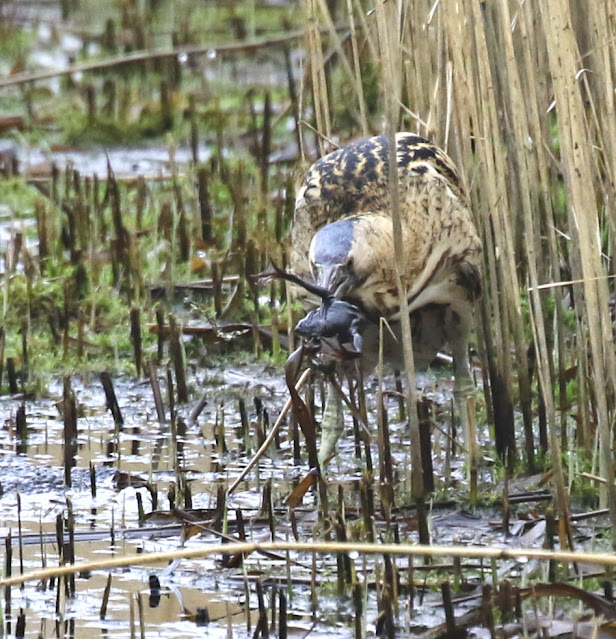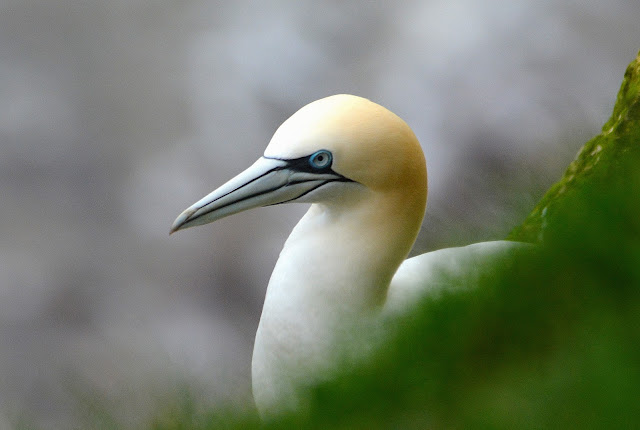Bittern
On Tuesday the forecast wasn’t very encouraging, but the heavy rain wasn’t due to start before 10am. When we arrived at 9am the rain had already begun, so as soon as everyone was clothed we went to Main Hide. It was quiet for the first 10 minutes, but then a very camouflaged Bittern was spotted putting its beak through the reeds. Shortly afterwards a second bird was seen. It was possible to discern that the male had a bluish colour at the base of the bill, and he was more strongly marked with dark colouration on his head and at the tips of his wings. He also appeared to be larger than the female. When the Bitterns were still in the channel a couple of Water Rail ran back and forth, and a Cetti's Warbler was also flying around. We also saw a pair of Bearded Tits flying low over the water and into a small reedbed to the right of the Bitterns.
Pair of Bitterns
Ditto
Ditto
Ditto
Ditto
Ditto
Ditto
Male Bittern
Female Bittern
Catching a Frog
Ditto
Water Rail
Male Marsh Harrier
Ditto
Female Marsh Harrier
The wind was blowing into Target Lake and Reedy Hide, so we didn’t see much to add there, but a little seed placed on the gate resulted in a few species including an unexpected Long-tailed Tit.
Chaffinch
Dunnock
Great Tit
Long-tailed Tit
Volunteers Working on a Tern Raft
On Wednesday we returned to Bempton. We were very lucky because the day before there wasn’t a single Auk on the cliffs, but with the lifting of the drizzle and rain they were all back. The Tree Sparrows were very active near the car park, and appeared to be throwing out old nesting material from their boxes. Three kamikaze Pied Wagtails were chasing each other with reckless abandon through the car park.
Tree Sparrows
It was extremely windy from the outset, so there was no chance of Short-eared Owls, though they had been seen earlier that morning. We headed off along the path which cut diagonally across the field. The first place we came to Mosey Point had Razorbills, Guillemots and even some Puffins. We continued north passing Linnets, Reed Buntings, Meadow Pipits and Skylarks. There were quite a few Gannets flying along the cliff tops with others perched precariously on whatever ledges they could find. We eventually made it to Jubilee grandstand in the hope of birds of prey. We were unlucky in that regard, but we did see our closest Puffin here. A warden, Rich, who used to be on the course aeons ago, pointed out a possible Corn Bunting singing. It was difficult to hear above both the rain and the Skylark, but sure enough there was the “rattle of keys”, and we even saw one perched on dead flowers from last year and another on the barbed wire fence.
Razorbill
Razorbill (c) 2024 Symon Fraser
Razorbill (c) 2024 Peter Moizer
ditto
ditto
'Bridled' Guillemot (c) 2024 Tony Robinson
Fulmar (c) 2024 Symon Fraser Fulmars (c) 2024 Peter Moizer
Gannet
Gannets (c) 2024 Symon Fraser
Gannet (c) 2024 Mike Hind
'Fencing' Gannets (c) 2024 Peter Moizer
'Fencing' Gannets c) 2024 Tony Robinson
Gannet c) 2024 Tony Robinson
Puffins
Puffin (c) 2024 Symon Fraser
Ditto
Puffins (c) 2024 Mike Hind
Herring Gull (c) 2024 Peter Moizer
Record Shot of Distant Corn Bunting From here we walked all the way south to Staple Newk, which was festooned with Gannets. Most of the other rocky cliff species were here, including our first Shag of the day.
Jackdaw (c) 2024 Symon Fraser
Shag
Seal
Something to do with Turbines?
Some of the morning group went on to Burton Riggs on the outskirts of Scarborough.
Red-Necked Grebe (c) 2024 Tony Robinson
ditto
ditto
Cormorant (c) 2024 Tony Robinson
Dunnock (c) 2024 Tony Robinson
On Thursday we went to Fairburn Ings. Pick-Up hide was fairly quiet with just Reed Bunting and Coal Tit visiting the feeders. Several Herons were flying back and forth from their nearby colony. When we started walking again Elaine found a Treecreeper then we discovered 3 Lesser Redpolls. There was absolutely nothing at the Kingfisher screen. As we climbed the first hill we could hear a distant Bittern, and Jan heard a Green Woodpecker. We then saw one fly across the river Aire and land in a tree on the opposite bank.
Lesser Redpoll
ditto
Reed Bunting
Skylark
ditto
Skylark (c) 2024 Paul Green
At the first lake there were Little Grebes, Tufted Ducks and Pochard. As we walked along we had brilliant views of a few Skylarks. We carried on walking the circuit until we were at the NW corner. Here, we saw 2 Great White Egrets, some distant Cattle Egrets (5?) and possibly 3 Spoonbills. There were also a sprinkling of wildfowl including Goldeneye, Teal and Shoveler.
Record Shot of GWE
Record Shot of Cattle Egret
Record Shot of Spoonbill
Heron
ditto
On the return journey the best bird was at the Kingfisher screen - a Heron. It even caught a small fish while we were its captive audience. At the start of the afternoon session we had a Kingfisher on the stream leading to the screen, whilst the Heron was still in position. It had deserted its post by the time we limped back to the car park.
Heron (c) 2024 Paul Green
On a Mobile Phone (c) 2024 Margaret Richardson
Heron Video From Mobile (c) 2024 Margaret Richardson
On Friday we returned for our penultimate visit to the Southern Wolds. We saw plenty of Buzzards and one close Red Kite, but the light was pretty awful. We saw a flock of fieldfare heading west when we began, and a smaller flock of Redwing heading in the same direction when we just about to return to our vehicles. in between those sightings the most obliging birds were the two gay Grey Wagtails, which were still in the weir area.
Grey Wagtail
ditto
The Less Flashy Male
ditto
The More Dandified Male
ditto
Redwing
Record Shot of Redwing
Finally, a couple of photos from Antarctica.
Southern Lapwing in Ushuaia (c) 2024 Ian Puckering
Massive Flock of Sooty Shearwaters (c) 2024 Ian Puckering




























%201.JPG)















.JPG)
.JPG)
.JPG)



































No comments:
Post a Comment